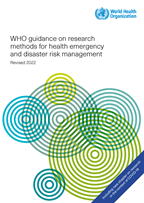- Home/
- Our Work/
- Health Emergencies/
- Research Methods/
- Sections and chapters/
- Section 5: Special topics to demonstrate research processes and benefits/
- Chapter 5.2 Crowdsourcing to gather data
Section 5: Special topics to demonstrate research processes and benefits
Chapter 5.2 Crowdsourcing to gather data

Research Methods for Health EDRM
Section navigation
Authors: Wazny K.
Chapter 5.2 describers the fundamentals of crowdsourcing and its relevance to Health Emergency and Disaster Risk Management (Health EDRM), including:
- What crowdsourcing is.
- How crowdsourcing differs from related terms.
- Strengths and limitations of crowdsourcing.
- Things to consider when designing a study that would use crowdsourcing to gather data.
What is this chapter about?
Crowdsourcing is an underused method for harnessing the knowledge, creativity, or sheer person-power of many people at once. It can help Health EDRM researchers rapidly collect data, in turn delivering timely evidence to decision-makers at low cost by leveraging communities’ access to technology.
This chapter describes the fundamentals of crowdsourcing and its relevance to Health EDRM. It discusses technology-based crowdsourcing, which is a relatively new research tool, and shows how this might help Health EDRM research. The chapter also presents a classification of the types of problems that crowdsourcing can solve, including crowd processing, crowd rating, crowd solving and crowd creation. It describes several crowdsourcing applications including BioGames (a malaria diagnostics video game), OpenZika Project (a data-driven simulation application of potential drug candidates for Zika) and MoBuzz (a participatory epidemiology application to combat dengue in Sri Lanka) and provides case studies, both in the Health EDRM context and within health more generally. The chapter concludes with factors to consider when designing a study that will use crowdsourcing.
Case studies presented in the chapter:
- A historical example of using crowdsourcing in estimating the weight of an ox.
- The use of Ushahidi SMS crowdsourcing to provide information to first responders during the 2010 Haiti earthquake
- Mapping schools and healthcare facilities using Open Street Map in earthquake-prone Nepal.
What are the key messages of this chapter?
- Although crowdsourcing is still a nascent field, it has huge potential for health EDRM.
- Crowdsourcing can be a low-cost, rapid alternative to traditional data collection methods.
- There are several different problems that crowdsourcing can be used to solve, including crowd processing, crowd rating, crowd solving, and crowd creation.
- Several open-source applications exist which can be used for crowdsourcing studies.
